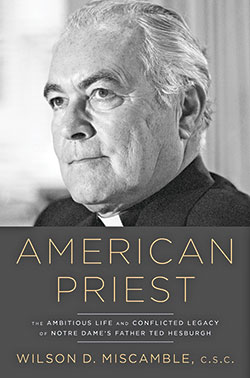Father Hesburgh biography ‘even-handed’ approach to a consequential life
Reviewed by Sean Gallagher
 Throughout the history of the Church in America, Catholics here have lived with a tension.
Throughout the history of the Church in America, Catholics here have lived with a tension.
In some ways, their faith has made them outsiders in the prevailing culture, leading them to be marginalized and even persecuted.
In other ways, Catholics in America have embraced the principles that have historically guided society here that are in harmony with the Gospel, nurturing a relationship that has born great fruit in promoting the common good.
The life of the late Holy Cross Father Theodore Hesburgh demonstrated this tension as it was experienced in the wide and varied changes for Catholics in America in the 20th century.
So, the title of a new biography of the longtime president of the University of Notre Dame, American Priest: The Ambitious Life and Conflicted Legacy of Notre Dame’s Father Ted Hesburgh, by Holy Cross Father Wilson Miscamble, encapsulates well that tension.
At his core, Father Hesburgh saw himself as both a priest and an American. At times, these two aspects of his identity brought him into conflict with leaders of American government and the shepherds of the Church—conflicts that were sometimes fruitful and at other moments damaging.
Examining Father Hesburgh’s complex life and perceiving how it was emblematic of the place of Catholics in American society in the second half of the 20th century is a challenging task, but one taken up ably by Father Miscamble, an expert on Cold War-era America and a history professor at Notre Dame.
The challenge of writing a biography of Father Hesburgh is only increased when considering his place in tensions within the Church in the U.S. in the decades following the conclusion of the Second Vatican Council in 1965.
On the one hand, he embodied well the council’s call for the faithful to apply the Gospel to challenges facing the contemporary world in his advocacy for racial reconciliation and for aid to people suffering in such diverse places as southeastern Asia and Central America.
At the same time, Father Hesburgh was a principal leader in the movement to distance Catholic universities from the leadership of the Church, and to promote an understanding of academic freedom that gives little or no consideration to the normative nature of the Church’s authentic teachings.
Father Miscamble, though publicly known for his critique of the direction in which Father Hesburgh took
Notre Dame and for seeking to reinvigorate its Catholic identity, navigated these complexities well and fairly.
He praised Father Hesburgh where praise was warranted, which was often and in varied circumstances, such as his unstinting dedication to priestly ministry and his work on the U.S. Civil Rights Commission.
Father Miscamble also did not hesitate to question some of Father Hesburgh’s changing priorities and their negative effects on the broader Catholic community in the United Sates.
For example, when Father Hesburgh first became president of Notre Dame in 1952, he publicly dedicated himself to shaping the university according to the principles of Blessed John Henry Newman.
The 19th-century English scholar, Catholic convert and soon-to-be saint wrote how fields of study at a Catholic university should be integrated together in a single pursuit of the truth and its many aspects, with the study of theology holding a prime place among its scholars.
By the early 1960s, however, Father Hesburgh had abandoned the project and instead sought to model Notre Dame after top-flight secular universities in the U.S. so that it could be viewed as a peer of such schools as Harvard, Yale and Stanford.
One step he took to raise Notre Dame’s profile was to associate himself with influential politicians, business leaders and foundations. He had close ties to the Ford Foundation and was a member of the board of the Rockefeller Foundation.
Both organizations promoted and still advocate for causes in society that run counter to Catholic moral teaching, such as various strategies to further population control, including abortion.
Father Miscamble suggests that Father Hesburgh’s desire to maintain positive ties to such influential organizations may have led him to remain largely silent on the legalization of abortion at a time when his moral authority in the U.S. was at an all-time high.
Father Miscamble’s even-handed approach in recounting and evaluating Father Hesburgh’s life may be somewhat surprising to readers lightly familiar with the subject of the book because Father Hesburgh was broadly lionized, sometimes in almost hagiographic terms, after his 2015 death.
Other readers, more closely tied to Notre Dame or observant of the trends affecting the Church in the U.S. during the past half century, may have differing opinions on the biography based on their views regarding those trends.
Although he died only four years ago, Father Hesburgh retired from leading Notre Dame in 1987. So, I think that there has been enough time in the interim for a qualified historian like Father Miscamble to have a proper perspective on the relevance and ongoing legacy of a priest who led such a consequential life.
In American Priest, Father Miscamble brings his broad talents in research and writing to bear on a topic whose importance ranges across the country and around the world, far beyond Notre Dame’s campus in northern Indiana.
(Sean Gallagher is a reporter for
The Criterion, newspaper of the Archdiocese of Indianapolis.) †
